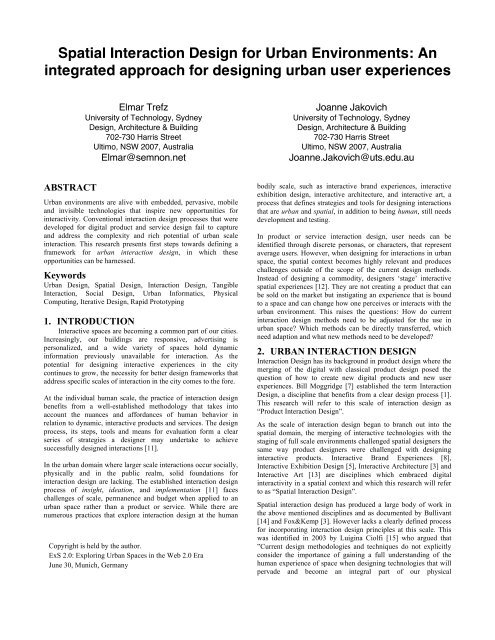Spatial Interaction Design for Urban Environments - WordPress ...
Spatial Interaction Design for Urban Environments - WordPress ...
Spatial Interaction Design for Urban Environments - WordPress ...
You also want an ePaper? Increase the reach of your titles
YUMPU automatically turns print PDFs into web optimized ePapers that Google loves.
<strong>Spatial</strong> <strong>Interaction</strong> <strong>Design</strong> <strong>for</strong> <strong>Urban</strong> <strong>Environments</strong>: Anintegrated approach <strong>for</strong> designing urban user experiencesElmar TrefzUniversity of Technology, Sydney<strong>Design</strong>, Architecture & Building702-730 Harris StreetUltimo, NSW 2007, AustraliaElmar@semnon.netJoanne JakovichUniversity of Technology, Sydney<strong>Design</strong>, Architecture & Building702-730 Harris StreetUltimo, NSW 2007, AustraliaJoanne.Jakovich@uts.edu.auABSTRACT<strong>Urban</strong> environments are alive with embedded, pervasive, mobileand invisible technologies that inspire new opportunities <strong>for</strong>interactivity. Conventional interaction design processes that weredeveloped <strong>for</strong> digital product and service design fail to captureand address the complexity and rich potential of urban scaleinteraction. This research presents first steps towards defining aframework <strong>for</strong> urban interaction design, in which theseopportunities can be harnessed.Keywords<strong>Urban</strong> <strong>Design</strong>, <strong>Spatial</strong> <strong>Design</strong>, <strong>Interaction</strong> <strong>Design</strong>, Tangible<strong>Interaction</strong>, Social <strong>Design</strong>, <strong>Urban</strong> In<strong>for</strong>matics, PhysicalComputing, Iterative <strong>Design</strong>, Rapid Prototyping1. INTRODUCTIONInteractive spaces are becoming a common part of our cities.Increasingly, our buildings are responsive, advertising ispersonalized, and a wide variety of spaces hold dynamicin<strong>for</strong>mation previously unavailable <strong>for</strong> interaction. As thepotential <strong>for</strong> designing interactive experiences in the citycontinues to grow, the necessity <strong>for</strong> better design frameworks thataddress specific scales of interaction in the city comes to the <strong>for</strong>e.At the individual human scale, the practice of interaction designbenefits from a well-established methodology that takes intoaccount the nuances and af<strong>for</strong>dances of human behavior inrelation to dynamic, interactive products and services. The designprocess, its steps, tools and means <strong>for</strong> evaluation <strong>for</strong>m a clearseries of strategies a designer may undertake to achievesuccessfully designed interactions [11].In the urban domain where larger scale interactions occur socially,physically and in the public realm, solid foundations <strong>for</strong>interaction design are lacking. The established interaction designprocess of insight, ideation, and implementation [11] faceschallenges of scale, permanence and budget when applied to anurban space rather than a product or service. While there arenumerous practices that explore interaction design at the humanCopyright is held by the author.ExS 2.0: Exploring <strong>Urban</strong> Spaces in the Web 2.0 EraJune 30, Munich, Germanybodily scale, such as interactive brand experiences, interactiveexhibition design, interactive architecture, and interactive art, aprocess that defines strategies and tools <strong>for</strong> designing interactionsthat are urban and spatial, in addition to being human, still needsdevelopment and testing.In product or service interaction design, user needs can beidentified through discrete personas, or characters, that representaverage users. However, when designing <strong>for</strong> interactions in urbanspace, the spatial context becomes highly relevant and produceschallenges outside of the scope of the current design methods.Instead of designing a commodity, designers ‘stage’ interactivespatial experiences [12]. They are not creating a product that canbe sold on the market but instigating an experience that is boundto a space and can change how one perceives or interacts with theurban environment. This raises the questions: How do currentinteraction design methods need to be adjusted <strong>for</strong> the use inurban space? Which methods can be directly transferred, whichneed adaption and what new methods need to be developed?2. URBAN INTERACTION DESIGN<strong>Interaction</strong> <strong>Design</strong> has its background in product design where themerging of the digital with classical product design posed thequestion of how to create new digital products and new userexperiences. Bill Moggridge [7] established the term <strong>Interaction</strong><strong>Design</strong>, a discipline that benefits from a clear design process [1].This research will refer to this scale of interaction design as“Product <strong>Interaction</strong> <strong>Design</strong>”.As the scale of interaction design began to branch out into thespatial domain, the merging of interactive technologies with thestaging of full scale environments challenged spatial designers thesame way product designers were challenged with designinginteractive products. Interactive Brand Experiences [8],Interactive Exhibition <strong>Design</strong> [5], Interactive Architecture [3] andInteractive Art [13] are disciplines which embraced digitalinteractivity in a spatial context and which this research will referto as “<strong>Spatial</strong> <strong>Interaction</strong> <strong>Design</strong>”.<strong>Spatial</strong> interaction design has produced a large body of work inthe above mentioned disciplines and as documented by Bullivant[14] and Fox&Kemp [3]. However lacks a clearly defined process<strong>for</strong> incorporating interaction design principles at this scale. Thiswas identified in 2003 by Luigina Ciolfi [15] who argued that”Current design methodologies and techniques do not explicitlyconsider the importance of gaining a full understanding of thehuman experience of space when designing technologies that willpervade and become an integral part of our physical


